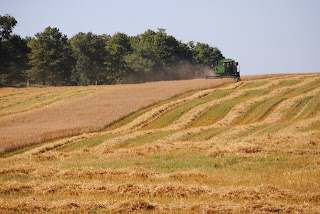Here the wheat is usually winter wheat, planted in late fall and showing like bright green grass before the first snow. It grows steadily in spring until the grains are clearly formed, and then in mid-July starts to turn golden brown. The fat grains of this wheat are what ends up making the bread you eat.


Once the wheat is ready for harvest, the combines move in, cutting off the grains at the top of the wheat stalk, and harvesting them seperately. The stalks are left lying on the ground to be baled as straw; the grain goes into those high-sided red wagons you see in farm fields at this time of year, and moves off, usually to be sold as a cash crop. The combine coming over the hill here is actually harvesting a field of mixed grain, but it's the best picture I have. In the next photo below, combining is finished, and baling has begun.


I think it took me many years, as an urbanite, to realize the difference between hay bales and straw bales. At first glance they look similar, but hay is cut and baled complete, that is with the seed head at the top of the grass included. It's the seed head that provides the protein for cattle fed on hay. With grain, the seeds are harvested separately by the combine, so it's only the stalks of the plants that get baled, as straw. Straw is mostly used for bedding, for all livestock, including horses.
 I think I first learned this difference when we used straw for mulch in our garden, because using hay introduces all kinds of grass and weed seeds, but using straw doesn't. So don't use hay for your garden mulch; it defeats the purpose!
I think I first learned this difference when we used straw for mulch in our garden, because using hay introduces all kinds of grass and weed seeds, but using straw doesn't. So don't use hay for your garden mulch; it defeats the purpose!
Grain mostly gets trucked off the farm (in those big grain trucks that rumble the roads of rural Ontario at this time of year), and taken to a grain elevator. Once it's weighed and graded the farmer gets paid, and the grain is probably exported, either by train or by ship. This is the Goderich grain elevator (the picture was taken, remarkably, the day before the tornado - it doesn't look quite like this any more), but most farmers will truck their grain to an inland elevator serviced by train.

These pictures reflect how virtually all our wheat is harvested, but driving to Goderich two weeks ago (where I got the picture of the grain elevator), we passed two farms where Mennonite farmers were actually stooking the wheat, the old-fashioned way. Picturesque to most of us, but incredibly hard work!

No comments:
Post a Comment